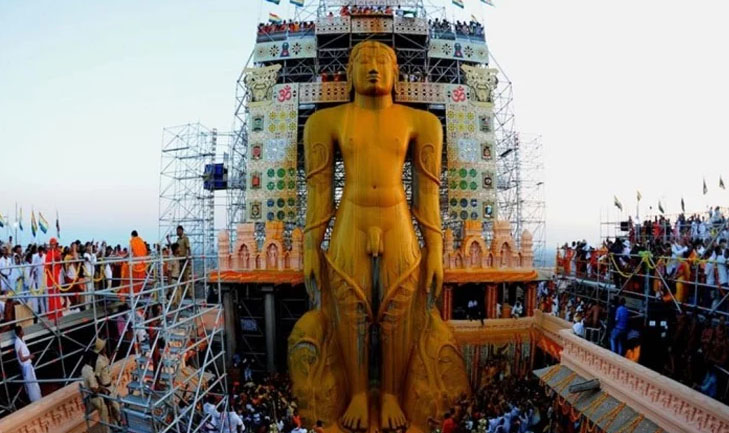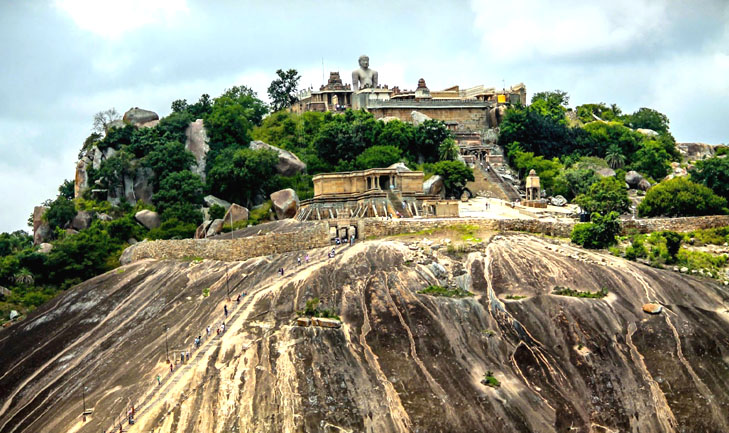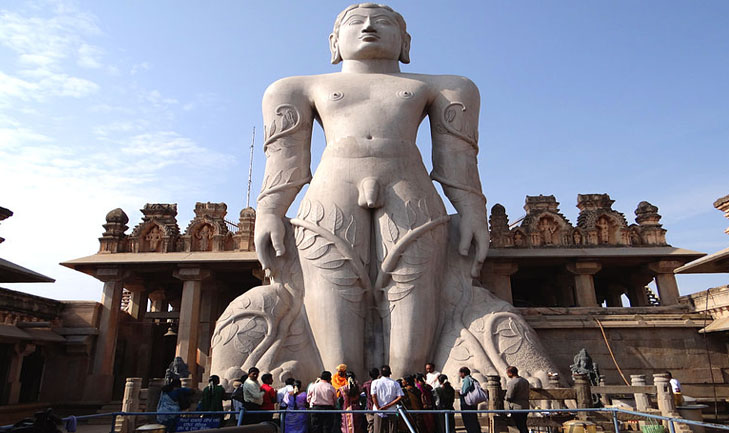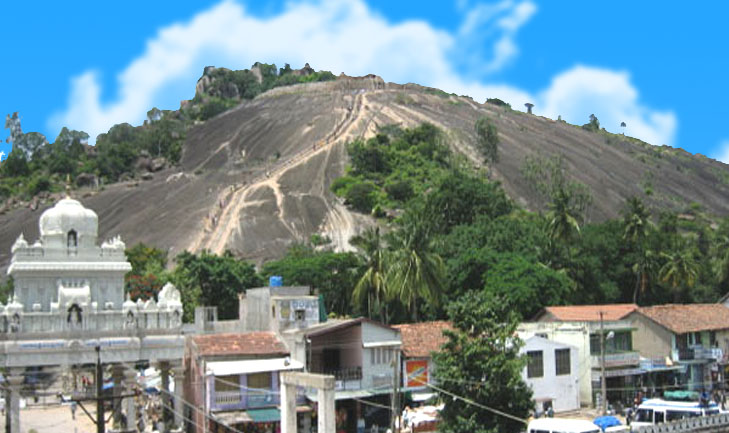Shri Shravanabelagola Tirth
Karnataka
 |
Location : 51 Kms. From Hassan, Karnataka, India
Railway Station : Hassan Railway Station
Shravanbelgola is the holiest pilgri-mage containing the relics of Lord Bahubali.
This is a pilgrimage upon which a status of one of the tallest statues of the world has been generally conferred. Generally too, wherever there are statues of Lord Bahubali in India, their heights are considerably much. The statue of Bahubali situated at Shravanbelgola measures 57 feet. The special feature of this statue is that it has been carved out of a mountain. The stone of the mountain and the stone of the statue are both joined to each other, interconnected and inseparable. This hill is 595 Metres higher from the foot-hill.
The Bahubali of Shravanbelgola is also called Gomateshwar. The word 'Gomat' is the synonym of summit. In view of the presence of the huge statue of Bahubali, it has become famous as Gomateshwar. The fame of this gigantic statue has spread to foreign countries. Thousands of Foreign tourists come here to see this huge statue. Millions of pilgrims visit this place every year. Mahamastakabhishek (the greatly auspicious ceremony when the head of the statue is washed with milk and crowned with flowers etc.) of Gomateshwar Bahubali is performed after every twelve years. Participating in this 'abhishek' (anointing with milk) ceremony is believed to bring good luck and virtue. The late Prime Minister Indira Gandhi had participated in this 'abhishek'. India has accepted this statue as the glory of its past and has also issued a commemorative postage stamp on it.
This statue of Lord Bahubali had been built in the 11th Vikram Century. According to available references, the mother of Shree Chamund Rai, Chief of Raja Gangras was going to Pondnapur in Samvat 1037 to have a glimpse of Bahubali. She took rest on the Chandragiri mountain opposite the Vindhyagiri mountain. It was here that some invisible power inspired her to install a huge statue of Lord Bahubali on the Vindhyagiri temple. Shree Chamund Rai opened the chests of his treasury to fulfill the wish of his mother. It was an extremely painstaking task, but the hand of some super power was behind this construction too, as a result of which, the huge image took concrete shape.
An interesting incident took place in the great consecration ceremony of this statue. The mixture of water, milk and sandal which was being poured over the statue's head dropped from its head directly to the ground. Until and unless the water and the milk poured over the head do not touch the feet, the consecration is said to be Incomplete. When after countless efforts this work could not be done, then at last a poor woman named Ajjikaguli achieved the glory of getting this incomplete ceremony completed. The Lord accepted the pure milk brought in the leaf bowls from a distant village. To commemorate this inspiring incident, a statue of Ajjikaguli was also built here.
Just in front of the Vindhyagiri mountain is the Chandragiri mountain. There are in all, seven temples on the Vindhyagiri whereas there are altogether fourteen temples on Chandragiri. It is said that nearly 2,000 years ago emperor Chandragupta had also visited this place accompanying Acharya Bhadrabahu swami. The emperor embraced death while in trance in course of his penance here. That is why this mountain came to be known as Chandragiri Parvat. The most ancient temple of Lord Aadinath stands here. There are also the foot prints of Acharya Bhadravahu Swami. There is also an incomplete statue which is said to be that of Lord Aadinath's son Chakravarti Bharat.
There is also a jain monastery at Shravanbelgola. Here seventeen divine statues made of nine jewels can also be seen.
Aavas - Different Dharamshalas
 |
-----------------------------------------------------
From : World Renowned Jain Pilgrimages Reverence And Art
By : Mahopadhyaya Lalitprabh Sagar
-----------------------------------------------------
Lord Bahubali, Shravanbelgola
Karnataka
9th -10th Cen.
 |
Shravanbelgola, a small village about 90 miles from Bangalore, lies picturesquely between two rocky hills. The larger hill known as Indragiri or Vindhyagiri, has on it the colossal idol of Gommateshwra, or Lord Bahubali. The statue standing in an open quadrangle in the Kayotsarga position is massive in size and majestic in conception.
The story of Gommateshwara has been an enduring theme in the art and literature of the Jains. Bahubali was the younger son of the first Jain Tirthankar, Lord Adinath. The "Dharma Yudha" duel (a war that prevents death and suffering on a large scale) between Bharat, his older brother, and the younger Bahubali, is an example of the inner strength of the human soul. In a three part duel (Drisht Yudha, Jal Yudha, and Wrestling) over their father's kingdom, Bahubali triumphed over his brother and could have become emperor, and yet in utter selflessness he renounced everything. Bahubali, is the ideal man who conquers selfishness, jealousy, pride and anger to attain salvation. Although, Lord Bahubali is not a Thirthankar, the Jains revere him as the first soul that attained Moksha during the present cosmic cycle.
Legend has it that Chamundaraya's, a General in the Ganga Empire, at the bequest of his mother set out on a pilgrimage and came across the two hills at Shravanbelgola, which was already venerated as a sacred spot by the Jains. Here, Chamundaraya chose the larger hill for the statue and ordered the carving of the monolith from a massive Rock at the peak of Indragiri Hill. The idol was consecrated in A. D. 980. According to local legend, it was Aristenemi, the sculptor, who carved the idol from a single granite rock. The head anointment ceremony is the tradition started by the Ganga General Chamundaraya at Shravanbelgola in 981 A. D. This ceremony, also known as Mahamastakabhisheka, has been celebrated once every 12 years for the last ten centuries. The next Mahamastakabhisheka (Anointment Ceremony) will be held in the year 2005.
The colossal idol of Bahubali, carved out of a single granite rock is the world's tallest monolith statue at slightly over 58 feet. It is worshipped not just for its beauty and size but for the principles it upholds -the triumph of man over physical desire. The gargantuan proportions of the sculpture have not reduced the sense offeeling and life in the sculpture. The body is perfectly proportioned and reflects effectively the serenity of a soul in search of enlightenment. The head with its curly spirals of hair and the expressive eyes seem to endow the statue with life. The sculptor has beautifully brought out the saint's steely determination in penance. The colossus stands in the Kayotasarga pose, a yogic position where the body is under complete control needing no sustenance nor performing any bodily functions. This highest stage of meditation is said to be "Shukla Dhyana," where the soul is fully engrossed in itself, free of all temporal bondages. This idol of Bhagwan Bahubali eloquently conveys the non- attachment, the enlightened self-absorption of the soul engrossed in itself, and the bliss of Dhyana achieved by the Yogi. It symbolizes complete detachment from the world. It expresses perfectly the concept of successful withdrawal from a world of desire and suffering, weakness and worry, and from the inevitability of birth and death. His serene smile radiates the successful achievement of total peace through the conquest of the inner turmoil.
The sheer grace of the granite idol resplendent against the backdrop of the Chanadragiri Hills is breathtaking, a site that would be forever etched in the memory of the onlooker.
Shravanbelgola is about 100 miles from Bangalore and 30 miles from Hassan and is easily accessible by air, road and train.
 |
-----------------------------------------------------
Information Source : Jaina Calendar - 2004, Published By Jaina, USA
-----------------------------------------------------
Mail to : Ahimsa Foundation
www.jainsamaj.org
R17111